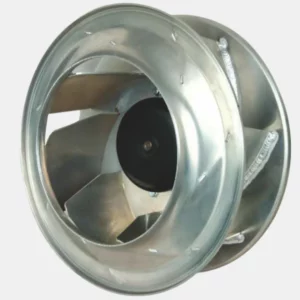EC (Electronically Commutated) backward curved centrifugal fans are primarily used in applications that require energy efficiency, precise airflow control, and low noise levels. The EC technology combines a backward curved impeller design with an energy-efficient electronically commutated motor.
Here are some situations where EC backward curved centrifugal fans are commonly used:
- HVAC Systems: EC backward curved centrifugal fans are often employed in HVAC systems, including air handling units (AHUs), rooftop units, and ducted systems. They offer high energy efficiency and precise airflow control, allowing for optimal temperature regulation and comfort in residential, commercial, and industrial buildings.
- Energy Recovery Ventilation (ERV): EC backward curved centrifugal fans are utilized in energy recovery ventilation systems. These systems exchange heat or energy between the outgoing and incoming air streams, ensuring energy efficiency and reducing heating or cooling costs in commercial buildings.
- Data Centers: EC backward curved centrifugal fans are well-suited for cooling systems in data centers and server rooms. They provide efficient and reliable cooling while minimizing energy consumption and ensuring proper airflow to prevent equipment overheating.
- Cleanroom Environments: EC backward curved centrifugal fans find applications in cleanroom environments, such as pharmaceutical manufacturing, semiconductor fabrication, and biotechnology. They deliver the necessary airflow with high efficiency and low noise levels, contributing to controlled air quality and particle containment.
- Air Purification Systems: EC backward curved centrifugal fans are used in air purification and filtration systems, including air purifiers and clean air cabinets. They provide energy-efficient airflow to draw air through filters, removing airborne particles, allergens, and pollutants, and improving indoor air quality in residential, commercial, and healthcare settings.
- Laboratory Fume Hoods: EC backward curved centrifugal fans are suitable for laboratory fume hoods, where the extraction of hazardous fumes and chemicals is necessary. They offer precise airflow control and low noise operation, ensuring a safe working environment for laboratory personnel.
- Commercial Kitchens: EC backward curved centrifugal fans can be employed in commercial kitchen exhaust systems. They efficiently remove smoke, grease, and odors generated during cooking, contributing to proper ventilation and maintaining a clean and comfortable environment in restaurant kitchens.
EC backward curved centrifugal fans are favored in applications where energy efficiency, precise airflow control, and low noise levels are essential. Their advanced motor technology allows for variable speed control and improved efficiency, resulting in energy savings and reduced operating costs.
How does the ec backward curved centrifugal fan work?
The EC (Electronically Commutated) backward curved centrifugal fan combines a backward curved impeller design with an energy-efficient electronically commutated motor.
Here’s a breakdown of how the EC backward curved centrifugal fan works:
- Electronically Commutated Motor: The fan is equipped with an EC motor, which is a brushless DC motor controlled by an electronic circuit. The EC motor allows for precise speed control and efficient operation.
- Power Conversion: The electronic circuit converts the incoming AC power supply to DC power. This DC power is then used to drive the EC motor.
- Variable Speed Control: The EC motor enables variable speed control, allowing the fan to operate at different speeds based on the desired airflow requirements. The speed of the motor can be adjusted using control signals or integrated sensors to maintain the desired airflow or pressure conditions.
- Backward Curved Impeller: The fan’s impeller consists of backward curved blades. These blades are designed to curve in the opposite direction of the fan’s rotation. When the motor spins the impeller, the backward curved blades generate centrifugal force.
- Airflow Generation: The centrifugal force generated by the backward curved blades causes the air to move radially outward from the center of the impeller. As the air moves outward, it gains velocity and kinetic energy.
- Air Discharge: The accelerated air is discharged into the fan housing in a direction perpendicular to the axis of rotation. The housing is designed to guide the airflow and direct it towards the desired outlet or ventilation system.
- Energy Efficiency: The EC motor provides high energy efficiency due to its brushless design and electronic control. It operates with minimal energy losses and can adjust its speed to match the required airflow, optimizing energy consumption.
- Precise Airflow Control: The variable speed control of the EC motor allows for precise airflow control. By adjusting the motor speed, the fan can deliver the desired airflow and pressure conditions, ensuring optimal performance and meeting specific application requirements.
- Low Noise Operation: The combination of the backward curved impeller design and the efficient EC motor contributes to low noise levels during fan operation. This makes EC backward curved centrifugal fans suitable for applications where noise reduction is important, such as HVAC systems and cleanroom environments.
The EC backward curved centrifugal fan’s electronically commutated motor and backward curved impeller design work together to provide energy-efficient and precisely controlled airflow. The variable speed control and low noise operation make it a desirable choice for applications that require efficient ventilation, such as HVAC systems, data centers, cleanrooms, and air purification systems.
